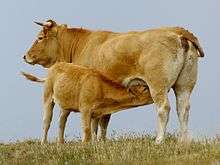Aubrac (cattle)
 Cow and calf on the Plateau de l'Aubrac | |
| Conservation status | FAO (2007): not at risk[1]:143 |
|---|---|
| Country of origin | France |
| Distribution | Auvergne, Languedoc-Roussillon, Midi-Pyrénées |
| Use | meat |
| Traits | |
| Weight | Male: 950 kg[2] |
| Female: 650 kg[2] | |
| Height | Male: 140 cm[2] |
| Female: 129 cm[2] | |
| Skin color | black |
| Coat | wheaten |
| Horn status | horned in both sexes |
|
Cattle Bos (primigenius) taurus | |

The Aubrac is a French breed of domestic beef cattle. It originates on the Plateau de l'Aubrac in the Massif Central in central southern France, from which it also takes its name. It has a wheat-coloured coat and dark hooves, switch, muzzle and eyes.
History
The Aubrac originated in the early nineteenth century on the Plateau de l'Aubrac in the Massif Central, which spans the modern départements of the Aveyron, the Cantal and the Lozère, in the regions of Auvergne-Rhône-Alpes and Occitanie.[2]
Some limited cross-breeding took place in the twentieth century: with the Mézine, now extinct, 1935–1945; with the Maraîchine, 1945–1955; and with the Parthenaise, 1955–1975.[2]
The conservation status of the Aubrac is not at risk.[1]:143 In 2014 the population was reported at about 170 000 head.[3]
Characteristics
The Aubrac is robust, frugal, fertile and long-lived, and is well adapted to the mountain environment of the Massif Central. It is reported to be resistant to trypanosomiasis, the "sleeping-sickness" transmitted by tsetse flies.
The Aubrac has a uniformly wheaten coat, with black skin and black hooves, black muzzle, tongue, switch, and natural openings. Bulls may carry darker markings to the coat.[2] The horns are lyre-shaped and tipped with black. Bulls stand about 140 cm at the withers and weigh about 950 kg; cows stand some 128 cm and weigh about 650 kg.[2][3]
Use
The Aubrac is raised for principally meat. Bullocks weigh about 310 kg when weaned.[2] Some milk from Aubrac cows is used in the production of Laguiole cheese; it is hoped that this proportion may reach 10%.[4]
References
- 1 2 Barbara Rischkowsky, D. Pilling (eds.) (2007). List of breeds documented in the Global Databank for Animal Genetic Resources, annex to The State of the World’s Animal Genetic Resources for Food and Agriculture. Rome: Food and Agriculture Organization of the United Nations. ISBN 9789251057629. Accessed November 2016.
- 1 2 3 4 5 6 7 8 9 Étude de la race bovine: Aubrac (in French). Bureau des Ressources Génétiques. Archived 6 July 2015.
- 1 2 Breed data sheet: Aubrac/France. Domestic Animal Diversity Information System of the Food and Agriculture Organization of the United Nations. Accessed November 2016.
- ↑ Les vaches de l’Aubrac: La race aubrac (in French). Le syndicat de défense et de promotion du fromage de laguiole A.O.C. - A.O.P. Accessed November 2016.
![]() Media related to Aubrac cattle at Wikimedia Commons
Media related to Aubrac cattle at Wikimedia Commons